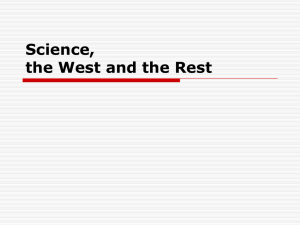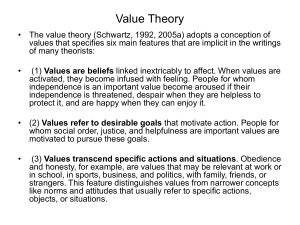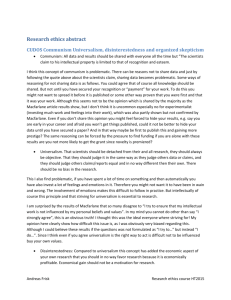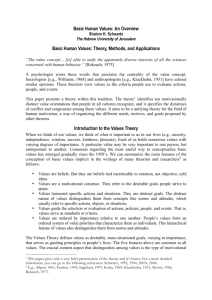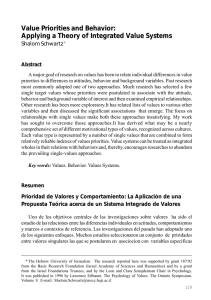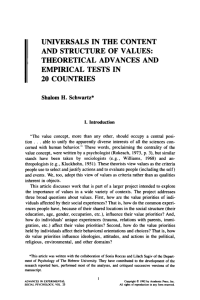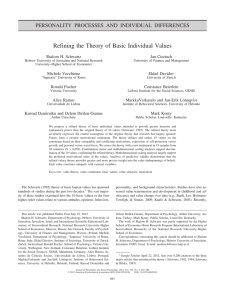Relations of everyday behavior to 19 underlying basic values Anna
advertisement
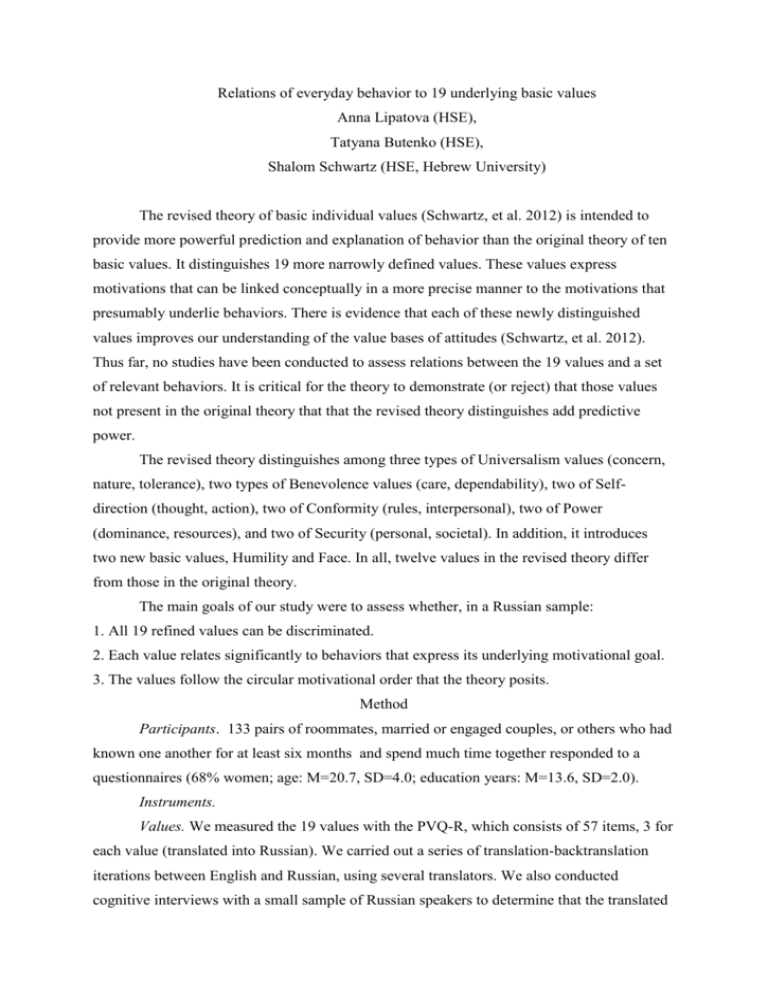
Relations of everyday behavior to 19 underlying basic values Anna Lipatova (HSE), Tatyana Butenko (HSE), Shalom Schwartz (HSE, Hebrew University) The revised theory of basic individual values (Schwartz, et al. 2012) is intended to provide more powerful prediction and explanation of behavior than the original theory of ten basic values. It distinguishes 19 more narrowly defined values. These values express motivations that can be linked conceptually in a more precise manner to the motivations that presumably underlie behaviors. There is evidence that each of these newly distinguished values improves our understanding of the value bases of attitudes (Schwartz, et al. 2012). Thus far, no studies have been conducted to assess relations between the 19 values and a set of relevant behaviors. It is critical for the theory to demonstrate (or reject) that those values not present in the original theory that that the revised theory distinguishes add predictive power. The revised theory distinguishes among three types of Universalism values (concern, nature, tolerance), two types of Benevolence values (care, dependability), two of Selfdirection (thought, action), two of Conformity (rules, interpersonal), two of Power (dominance, resources), and two of Security (personal, societal). In addition, it introduces two new basic values, Humility and Face. In all, twelve values in the revised theory differ from those in the original theory. The main goals of our study were to assess whether, in a Russian sample: 1. All 19 refined values can be discriminated. 2. Each value relates significantly to behaviors that express its underlying motivational goal. 3. The values follow the circular motivational order that the theory posits. Method Participants. 133 pairs of roommates, married or engaged couples, or others who had known one another for at least six months and spend much time together responded to a questionnaires (68% women; age: M=20.7, SD=4.0; education years: M=13.6, SD=2.0). Instruments. Values. We measured the 19 values with the PVQ-R, which consists of 57 items, 3 for each value (translated into Russian). We carried out a series of translation-backtranslation iterations between English and Russian, using several translators. We also conducted cognitive interviews with a small sample of Russian speakers to determine that the translated items were easily and accurately understood. Cognitive interviewing revealed problems with a number of items which we revised and checked in further cognitive interviews. Behaviors: We developed the behaviors instrument generating a set of 130 everyday behaviors that members of the general public might have opportunities to perform. Following the method of Bardi and Schwartz (2003), respondents rated their own and their partner’s behaviors on separate questionnaires. Here we present and discuss findings only for self-rated behavior. We conducted series of translation and backtranslation to insure similar nuances in both languages. We pretested this instrument three times, each round assessing convergent validity of items, inter-item correlations and item-to-total correlations for indexes based on the items. Based on these analyses, we dropped some items and revised the instrument adding new items for behavior sets whose internal reliabilities were too low. Finally, we selected 3-6 behavior items for each set that yield an internal reliability coefficient >.75, for a total of 85 items. Respondents indicated how frequently they had performed each behavior in the past year, relative to the number of opportunities they had to perform it. Response options were: ‘never’, ‘rarely’ (about a quarter of the times), ‘sometimes’ (about half of the times). ‘usually’ (more than half of the times), ‘always’, and ‘no opportunity’. Following are exemplary items (postulated value underlying value in parentheses): “collect food, clothing, or other things for needy families (universalism concern); “change plans spontaneously (simulation); “play down my achievements or talent (humility).” Procedure. The session was ordered as follows: reporting own values, rating other’s behavior, socio-demographic and familiarity questions, 5 minute distraction task, rating own behavior. As noted before the research was presented as a study of partner familiarity. Partners completed the questionnaires at the same time, but without consultation. The total time for the research session was about 50 minutes. Questionnaires were administered in written form either individually or in small groups and a few were completed without the researcher in written form or were emailed. Results To assess the distinctiveness of the 19 narrowly defined values, we performed confirmatory factor analyses. We could not estimate a single model with so many parameters (19 latent variables, 57 indicators) reliably with only 266 cases. We therefore ran four analyses, one for each higher-order value. The final models included no cross-loadings or correlated errors. It was necessary to drop one item each from the following four values: Selfdirection Thought, Power Resources, Security Personal and Security Societal. It was also necessary to combine Self-direction Thought and Self-direction Action. It is important to note, that in hundreds of studies with the earlier 10 value theory, an average of 2 values had to be combined; so this result is very encouraging. All remaining items had loadings above .4 on their postulated latent value and all correlations among latent values were <.8. Table 1 shows the final fit indexes after a few modifications for each higher-order value. Table 1. Fit-indexes of models for each higher-order value. χ2 Df CFI SRMR RMSEA Self-transcendence 211.97 80 .910 .066 .079 Openness to change 101,707 41 .907 .054 .078 Self-enhancement 118,527 38 .913 .065 .089 Conservation 183,080 89 .913 .052 .063 To assess the structure of relations among the 19 values and their locations around the circular motivational continuum, we performed a multidimensional scaling analysis. Figure 1 presents the results. All items are in the region of their own value. The multidimensional scaling analysis largely supported the theoretically predicted motivational order of 19 values. Benevolence, which is in the center, is the exception. Benevolence Care is central to Universalism Concern and Universalism Tolerance. Benevolence Dependability is central to Self-Direction Thought and Self-direction Action. Figure 1. Multidimensional scaling plot of 53 value items retained in the CFA analysis (Stress 1 .226, DAF .95, TCC .97). We next examined relations among the 19 more narrowly defined values and their corresponding behavior sets. For this purpose we calculated correlations between the latent variable for each of the 19 values and its corresponding behavior set, using structural equation modeling. We examined the subtypes of Self-Direction both separately and combined as suggested by the CFA. Table 2 presents the results. Table 2. Correlations between values and behaviors. Value Number of Behavior Items Value-Behavior correlation in same domain Self-Direction Thought 4 .24 Self-Direction Action 4 .39 } .35 Stronger correlation with other behavior Stimulation 3 .48 Hedonism 4 .58 Achievement 4 .48 Power Dominance 3 .46 Power Resources 3 .51 Face 5 .66 Security Personal 6 .49 Security Societal 4 .48 Tradition 4 .64 Conformity Rules 5 .42 Conformity Interpersonal 4 .41 Humility 5 .43 Universalism Nature 3 .46 Universalism Concern 5 .24 Universalism Tolerance 4 .51 Benevolence Care 4 .58 Benevolence Dependability 3 .49 BED.39, UNT .37 Correlations ranged from .24 for Self-Direction Thought and for Universalism Concern to .66 for Face. All 19 correlations were significant at the .01 level. For every value but Universalism Concern, the highest correlation of the value was with its corresponding behavior set. Universalism Concern values correlated more highly with Benevolence Dependability behaviors and with Universalism Tolerance behaviors than with the behaviors expected to express Universalism Concern. Conclusions Results of the study lead to the following conclusions: 1. The new, more narrowly defined values in the refined theory are distinguishable in a Russian sample, with the exception of the two subtypes of self-direction that must be combined. 2. The 19 values are ordered in the circular motivational continuum postulated by the theory. 3. Each value correlates significantly and most strongly with the behaviors it is postulated to underlie, with the exception of Universalism concern that correlates more strongly with the behaviors associated with its adjacent values in the circle. References Bardi, A., & Schwartz, S. H. (2003). Values and behavior: Strength and structure of relations. Personality and Social Psychology Bulletin, 29, 1207-1220. Schwartz, S.H., Cieciuch, J., Vecchione, M., Davidov, E., Fischer, R., Beierlein, C., Ramos, A., Verkasalo, M., Lönnqvist, J.-E.,Demirutku, K., Dirilen-Gumus, O., & Konty, M. (2012). Refining the theory of basic individual values. Journal of Personality and Social Psychology.
